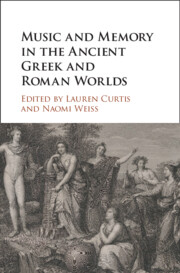Book contents
- Music and Memory in the Ancient Greek and Roman Worlds
- Music and Memory in the Ancient Greek and Roman Worlds
- Copyright page
- Contents
- Figures
- Contributors
- Acknowledgments
- Note on Texts and Abbreviations
- Part I Approaching Music and Memory
- Part II Music, Body, and Textual Archives
- Part III Technologies of Musical Memory
- Chapter 5 Do Alexandrians Dream of Electric Sound?
- Chapter 6 Teichoacoustics, or the Wall as Sonic Medium in Antiquity
- Part IV Audience, Music, and Repertoire
- Part V Music and Memorialization
- Bibliography
- General Index
- Index Locorum
Chapter 5 - Do Alexandrians Dream of Electric Sound?
Recording Music in the Early Ptolemaic Empire
from Part III - Technologies of Musical Memory
Published online by Cambridge University Press: 14 October 2021
- Music and Memory in the Ancient Greek and Roman Worlds
- Music and Memory in the Ancient Greek and Roman Worlds
- Copyright page
- Contents
- Figures
- Contributors
- Acknowledgments
- Note on Texts and Abbreviations
- Part I Approaching Music and Memory
- Part II Music, Body, and Textual Archives
- Part III Technologies of Musical Memory
- Chapter 5 Do Alexandrians Dream of Electric Sound?
- Chapter 6 Teichoacoustics, or the Wall as Sonic Medium in Antiquity
- Part IV Audience, Music, and Repertoire
- Part V Music and Memorialization
- Bibliography
- General Index
- Index Locorum
Summary
This chapter explores two strategies for preserving the memory of live music in early Ptolemaic Egypt by reading Posidippus’ epigram (37 AB) on Arion’s lyre next to Hedylus’ epigram (4 GP) on an automated rhyton in the shape of the Egyptian god Bes. While Arion’s lyre captures the essence of a classic but long-dead virtuoso in amber, the rhyton performs its song on endless repeat. I suggest that the automated rhyton, as interpreted by Hedylus, represents an attempt to create an eternal first performance of a type of song that could represent the Graeco-Egyptian Ptolemaic empire: a hymn to the Nile.
Keywords
- Type
- Chapter
- Information
- Music and Memory in the Ancient Greek and Roman Worlds , pp. 123 - 147Publisher: Cambridge University PressPrint publication year: 2021

